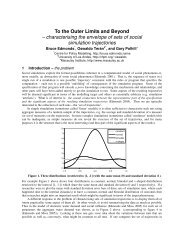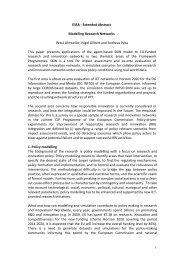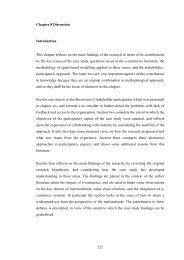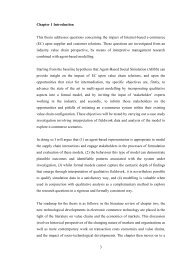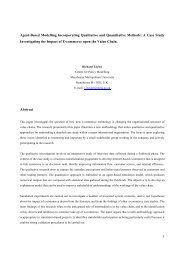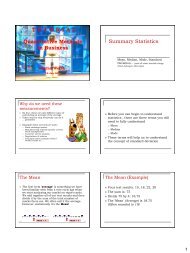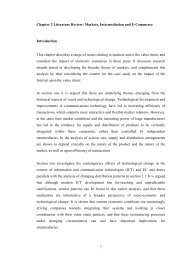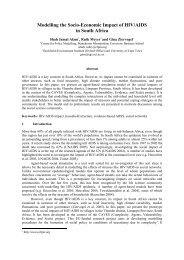A. List of Model Parameters. B. Model Technical Description
A. List of Model Parameters. B. Model Technical Description
A. List of Model Parameters. B. Model Technical Description
You also want an ePaper? Increase the reach of your titles
YUMPU automatically turns print PDFs into web optimized ePapers that Google loves.
Appendix-A: <strong>List</strong> <strong>of</strong> <strong>Model</strong> <strong>Parameters</strong><br />
291
In this appendix, we present a list <strong>of</strong> model parameters and their default values<br />
including assumed constants that require validation as future work. These<br />
parameters are in addition to the model description and behavioural rules that<br />
we have discussed in Chapter 4. Table 41 presents values <strong>of</strong> the model<br />
parameters that have are used as default in the simulation experiments<br />
reported in Chapter 5 <strong>of</strong> this thesis. The far right column indicates the source <strong>of</strong><br />
these values: ‘LT’ refers to values adapted from external references and<br />
sources and ‘DE’ means that our case study partners and other domain experts<br />
have suggested the respective values. Finally, ‘UV’ corresponds to unvalidated<br />
assumptions that have been introduced in the model in the absence <strong>of</strong> available<br />
evidence during the course <strong>of</strong> this research. We hope that these values may be<br />
validated or replaced with better-informed guesses following further evidencegathering<br />
processes.<br />
292
Table 41: <strong>List</strong> <strong>of</strong> model parameters and their default values/ranges: ‘LT’: values adapted from other sources; ‘DE’: input from domain<br />
experts/case study partners; ‘UV’: unvalidated assumptions due to lack <strong>of</strong> evidence<br />
Parameter Default value <strong>Description</strong> Status<br />
General Setting<br />
churchParticipationRate 0.8 Proportion <strong>of</strong> households being member <strong>of</strong> a church<br />
clusterProportion 25 Number <strong>of</strong> households per moiety<br />
healthExpenditure True Flag to turn health expenditure: on (true) <strong>of</strong>f (false)<br />
HIV True Flag to turn HIV spread in the simulation: on (true) <strong>of</strong>f (false)<br />
initialFuneralClubs 9 Number <strong>of</strong> initial funeral clubs<br />
initMigratedAgents 0.03 Initial proportion <strong>of</strong> migrant agents<br />
networkRecordInterval 10 Interval at which the generated networks are recorded<br />
numDenominations 4 Number <strong>of</strong> church denomination<br />
numHouseholds 150 Initial number <strong>of</strong> households<br />
seed 1199995797250l Seed for the random number generators<br />
showGUI False Flag to turn the GUI on (true) or <strong>of</strong>f (false)<br />
Agent Related<br />
agentLoseJobChance 0.01 Chance for an migrant agent to lose job UV<br />
agentStopMigrationAge 55 Age at which an individual agent stop LT<br />
amountReqdMigration 1000 Rand Amount required for migration for an agent in Rand DE<br />
birthrate 23 Birth rate per 1000 person per year LT<br />
chanceMigrationFemale 0.03 Chance for migration for male agent DE<br />
chanceMigrationMale 0.15 Chance for migration for male agent DE<br />
femaleActiveSexAge [13, 45] years Age range for sexually active female agents that participate in courtship LT<br />
fertilityAgeLimit Normal (40, 5) Fertility age limit for a female agent sampled from Normal distribution LT<br />
friendshipLimit 7 Upper limit for number <strong>of</strong> friends for an individual agent UV<br />
infantMortalityRate 52 Infant mortality rate per 1000 person per year LT<br />
lobola 10,000 Rand Maximum amount for lobola DE<br />
maleActiveSexAge [16, 55] years Age range for sexually active male agents that participate in courtship LT<br />
maxCourtshipDuration Lognormal(0.9, 0.7) Maximum dating time for an agent sampled from truncated lognormal distribution within range [12, 18] months LT<br />
maxSexPartnerFemale Lognormal(0.2, 0.3) Maximum sex partners for a female agent at a time sample sampled from Lognormal distribution LT<br />
maxSexPartnerMale Lognormal(0.4, 0.7) Maximum sex partners for a male agent at a time sample sampled from Lognormal distribution LT<br />
migrantVisitFreq Uniform(3, 5) Frequency <strong>of</strong> visit <strong>of</strong> migrant agents to home LT<br />
number<strong>of</strong>MigrationTries Uniform(3, 9) Number <strong>of</strong> months that an agent waits until it attempts to migrate again UV<br />
randomParnerProb 0.05 Probability for picking a random partner UV<br />
singelRemittanceLimit Uniform(24, 48) Number <strong>of</strong> months for an unmarried agent to send remittances; range sampled from Uniform distribution UV<br />
chanceLooseJob 0.01 Chance for a migrant agent to lose job UV<br />
293
Parameter Default value <strong>Description</strong> Status<br />
Mining Related<br />
miningStartTime 61 Mining starts at the 5 th year UV<br />
outsiderAgeRange Normal(29, 5) Age range for outsider agents; sampled from truncated Normal with range [16, 40] years LT<br />
outsiderMineTrainProb 0.001 Chance that an outsider agent is an skilled mineworker UV<br />
outsiderWaitingTime Uniform(1, 5) Number <strong>of</strong> months that an outsider agent waits without a job at mine UV<br />
skilledCapacity 100 Maximum number <strong>of</strong> skilled agents that can be employed at the mine UV<br />
skilledWorkerSalary Normal(5000, 500) Monthly salary for skilled workers at the mine sampled from Normal distribution DE<br />
unskilledCapacity 350 Maximum number <strong>of</strong> unskilled agents that can be employed at the mine UV<br />
unskilledWorkerSalary Normal(1000, 250) Monthly salary for unskilled workers at the mine sampled from Normal distribution DE<br />
Funeral Clubs Related<br />
fc_GracePeriod 6 months Grace period for members without paying dues UV<br />
fcCapacity Uniform(11, 19) Maximum number <strong>of</strong> funeral club members per club in the model UV<br />
fcInitialMoney 10,000 Rand Initial money assigned to funeral clubs UV<br />
funeralClubDue 70 Rand Monthly funeral club fee paid by members DE<br />
maxFC_Cost 7500 Rand Maximum funeral cost for a bereaved household DE<br />
midFC_Cost 5000 Rand Average funeral cost for a bereaved household DE<br />
minFC_Cost 2500 Rand Minimum funeral cost for a bereaved household DE<br />
Savings Clubs (‘stokvel’) Related<br />
minStokvelMembers 3 Minimum number <strong>of</strong> members required to form a savings club UV<br />
probFacilitator 0.20 Chance for an agent to act as a facilitator for initiating a savings club UV<br />
stokvelFee 50 Rand Monthly savings club fee paid by members DE<br />
Household Related<br />
chanceBorrowFood 0.20 Chance for borrowing food in a month time UV<br />
chancePieceJob 0.75 Chance for an eligible household to announce piecewise jobs UV<br />
educationFee 20 Rand Monthly school fee per child agent UV<br />
healthExp 50 Rand Health expenditure per member <strong>of</strong> a household UV<br />
maxMoneyToFeed 165 Rand Maximum money required to feed an adult male DE<br />
maxStartWealth 2500 Rand Maximum starting wealth for households DE<br />
minMoneyToFeed 120 Rand Minimum money required to feed an adult male DE<br />
minStartWealth 1500 Rand Minimum starting wealth for households DE<br />
numPiecewiseJobs Uniform(1, 3) Number <strong>of</strong> piecewise jobs announced by an eligible households UV<br />
richHHCriteria 15,000 Rand Minimum wealth for a household required to announced piecewise jobs at household UV<br />
294
Appendix-B: <strong>Model</strong> <strong>Technical</strong> <strong>Description</strong><br />
295
The model is developed in Java and uses the Repast 3.1 Simulation toolkit<br />
(North et al. 2001). Figure 117 shows the UML diagram for the classes<br />
implemented in the model and those inherited from the Repast libraries. The<br />
source code along with the documentation is available in the CD attached to<br />
this thesis. It is also publicly available for download from the CAVES Project<br />
Portal – http://cfpm.org/caves/CAVESWiki/<strong>Model</strong>s<br />
(last accessed: 25/06/2008).<br />
Figure 117: UML class diagram showing the class relations and hierarchy in the model<br />
296
Running the model from the Repast<br />
Since the model is using Repast for its simulation infrastructure, simulation runs<br />
can be started from the Repast graphical user interface (GUI). Invoking the<br />
main() method <strong>of</strong> the model class (display.SouthAfrican<strong>Model</strong>) will bring up the<br />
Repast GUI (see the screenshot in Figure 118). One can change model settings<br />
from the GUI and start, pause or stop simulation runs from there.<br />
Figure 118: Screenshot <strong>of</strong> the model with the GUI<br />
Running the model from console as a batch run<br />
To save on time and memory it is possible to run the model from console. This<br />
is a so-called batch run in Repast terminology and is started by invoking the<br />
Repast class SimInit with the model class as parameter:<br />
java uchicago.src.sim.engine.SimInit -b display.SouthAfrican<strong>Model</strong><br />
Additional Java libraries<br />
The model requires the following libraries:<br />
• flanagan.jar - Michael Thomas Flanagan's Java Scientific Library<br />
(last accessed: 25/06/2008)<br />
297
• repast.jar – Repast Simulation Toolkit 3.1<br />
(last accessed:<br />
25/06/2008)<br />
• colt.jar – CERN Library for High Performance Scientific and <strong>Technical</strong><br />
Computing in Java<br />
(last accessed: 25/06/2008)<br />
Setting the classpath <strong>of</strong> the above libraries is necessary to run the model main<br />
class.<br />
<strong>Model</strong> Output<br />
The model produces output on several levels:<br />
GUI: friendship network and stokvel network (updated dynamically), extended<br />
family network, social links <strong>of</strong> the households in the village<br />
Files: complete model output. For each model run a folder is created in the<br />
specified output<br />
At every interval: networkRecordInterval, the sexual network, friendship network<br />
and households social links are output in Pajek format 109 .<br />
Time series data for labour activity, demographics, HIV/AIDS incidence and<br />
prevalence are output at every time step.<br />
109 Courtesy: Friedrich Krebs, CESR, Kassel<br />
298




